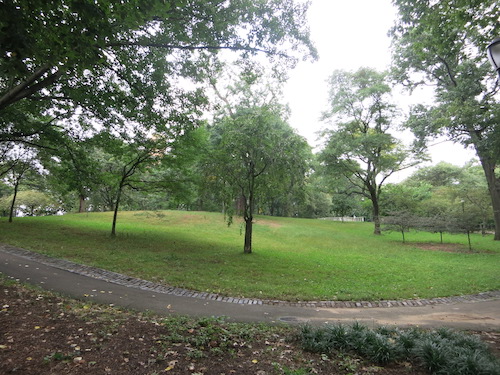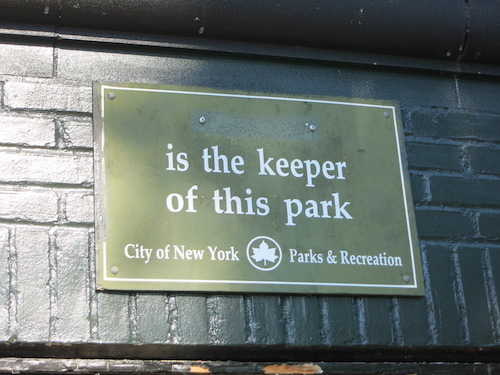Henry Hudson sailed up the river that came to bear his name in 1609. Nearly 200 years later, in 1807, Robert Fulton's North River Steamboat, the Clermont, made its maiden voyage up the Hudson River, then still called the North River. (The Dutch colonists had dubbed it the "North" to distinguish it from the Delaware, which they called the South River.)
A century after that, planners conceived a monument to the explorer to mark the 300th anniversary of Hudson's voyage and the 100th of the steamboat. There was no Henry Hudson Park at the time, but in 1909 builders broke ground on donated land in the Bronx's Spuyten Duyvil neighborhood and erected in 1912 the 100-foot Doric column that stands in today's park.

The idea was that a 100-foot monument on a 200-foot bluff would numerically as well as symbolically signify both of the historic anniversaries marked by the Hudson-Fulton Celebration.
The site dedication announcement included this wonderfully phrased explanation for the choice of location:
It was within view of the location of the monument that the historical conflict for the possession of the lands which now embrace the second largest City on earth, between the Indians and the white men took place, and it was here also that General Washington caused the erection of Fort No. 1, for the defense of the Hudson.It is, therefore, quite meet and appropriate that this spot was selected as the location of the proposed monument to the memory of the first explorer of the River bearing his name.
But the funding boat ran aground, and the column stood bare until the 1930s. Finally, flush with federal money, Robert Moses completed the nearby Henry Hudson Parkway and the Henry Hudson Bridge linking Manhattan and the Bronx; acquired the land for the Parks Department, and landscaped the park; and enlisted Karl H. Gruppe, then chief sculptor of the Parks Department's Monument Restoration Project, to complete a statue of Hudson to top the pillar, and create two bas-reliefs for the base. The monument was dedicated in 1938.


Like the statue of Christopher Columbus in Times Square, the Henry Hudson Monument has attracted controversy in line with challenges to memorials of Confederate heroes in the South. The object of complaint has not been the statue atop the pillar, but one of the two bas-reliefs at the base.
On one side is this harmless image:

But walk around to the back and you'll find a mystifying depiction of three native Americans including one kneeling before Hudson and presenting him with gifts. It's understandable that this might offend, leaving aside the fact that history doesn't record any such encounter. (Little is known of Hudson's interactions with the local Lenape.)

One Bronx activist told the Riverdale Press in 2017, "For a person like me who does work on racial justice issues…it is a jarring image."
The rest of the park is pretty but unassuming. Part of the monument plaza is undergoing some work, but the rest is nicely planted.

Curved walkways arc through the grass and trees.


A picturesque stone shed in one corner looks abandoned, but you never know.

The street-edges (the park is bisected by Kappock St.) expose impressive rock cross-sections.

Across Kappock in the other half of the park there's no monument – and evidently no keeper either.

No matter – it's a nice spot for recreation, both passive and active.


And on a sunny weekday afternoon in early fall, there's plenty of nobody, if that suits you.

I think there's a view of the Hudson River through these trees – or there will be when the branches are bare:

But for a prime panorama, stop off at Half Moon Overlook just west of the park. The Henry Hudson theme persists in the name of this tiny half-moon-shaped balcony park off Palisade Ave., named for Hudson's ship, the Halve Maen (Half Moon).

It offers a nice view of the river, along with a satisfying feeling of having discovered a New York City secret.



A blogger who explored the West Bronx back in 2007 just before leaving New York wrote in a post about the Spuyten Duyvil neighborhood that from Half Moon Overlook "you can scramble down a steep path that doesn't look like an official walkway. You pass old building foundations and cement pillars covered in graffiti. Once you get to the bottom, there is an open passage to the train tracks."
Next time I'm in the neighborhood I mean to investigate whether that's still the case. Maybe the path in question leads to Spuyten Duyvil Shorefront Park, which seemed to be closed for development when I tried to get to it, but appeared open (if troubled) in a Riverdale Press article from May 2018, just a few months ago. I never stop marveling at the never-ending scope of New York City's parks.
All photos © Jon Sobel, Critical Lens Media
No comments:
Post a Comment